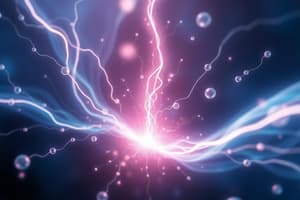Podcast
Questions and Answers
What determines the amount of time needed for electrophoresis?
What determines the amount of time needed for electrophoresis?
- Number of bands observed
- Color intensity of the dye
- Length of the gel, voltage used, and sizes of the molecules in the sample (correct)
- Presence of DNA ladders with tracking dyes
What is the purpose of DNA ladders containing tracking dyes in gel electrophoresis?
What is the purpose of DNA ladders containing tracking dyes in gel electrophoresis?
- To stain DNA samples
- To amplify DNA fragments
- To increase the speed of electrophoresis
- To monitor gel runs and ensure bands of interest are not masked by dyes (correct)
When should electrophoresis be stopped in relation to the migration of bromophenol blue dye?
When should electrophoresis be stopped in relation to the migration of bromophenol blue dye?
- Approximately when it has migrated 60% of the gel length (correct)
- After it migrates 80% of the gel length
- Regardless of its migration
- Before it migrates 40% of the gel length
Why is monitoring run time crucial in electrophoresis?
Why is monitoring run time crucial in electrophoresis?
What happens if run times are shorter than necessary in electrophoresis?
What happens if run times are shorter than necessary in electrophoresis?
How do DNA ladders with tracking dyes contribute to gel electrophoresis?
How do DNA ladders with tracking dyes contribute to gel electrophoresis?
What is the typical range for the voltage set in nucleic acid electrophoresis?
What is the typical range for the voltage set in nucleic acid electrophoresis?
What is the effect of low voltage in DNA electrophoresis?
What is the effect of low voltage in DNA electrophoresis?
Why is it important to monitor run time during electrophoresis?
Why is it important to monitor run time during electrophoresis?
What does it mean if the smallest molecules in the sample migrate off the gel during electrophoresis?
What does it mean if the smallest molecules in the sample migrate off the gel during electrophoresis?
What problem can occur if high voltage is applied during DNA electrophoresis?
What problem can occur if high voltage is applied during DNA electrophoresis?
How does constant voltage assist in running an electrophoresis gel?
How does constant voltage assist in running an electrophoresis gel?
What is the main purpose of gel electrophoresis in molecular biology?
What is the main purpose of gel electrophoresis in molecular biology?
Which type of support matrix is ideal for separating macromolecules like nucleic acids and protein complexes?
Which type of support matrix is ideal for separating macromolecules like nucleic acids and protein complexes?
What property of a biological molecule influences its mobility through an electric field during electrophoresis?
What property of a biological molecule influences its mobility through an electric field during electrophoresis?
In polyacrylamide gel electrophoresis, what is the main advantage of using a smaller pore size?
In polyacrylamide gel electrophoresis, what is the main advantage of using a smaller pore size?
Which factor does NOT affect the mobility of a biological molecule through an electric field during electrophoresis?
Which factor does NOT affect the mobility of a biological molecule through an electric field during electrophoresis?
Why is agarose gel preferred for separating macromolecules like nucleic acids and protein complexes rather than polyacrylamide?
Why is agarose gel preferred for separating macromolecules like nucleic acids and protein complexes rather than polyacrylamide?
Flashcards are hidden until you start studying
Study Notes
Running Electrophoresis
- Constant voltage is commonly employed in nucleic acid electrophoresis, with voltage typically set at 5-10 V/cm.
- The voltage to be applied (V) is equal to the distance between the electrodes (cm) multiplied by the recommended V/cm.
- Low voltage results in poor band resolution and diffusion, while high voltage can cause "smiling".
- Run conditions based on fragment size determine the amount of time needed for electrophoresis.
Run Time
- The length of the gel, voltage used, and sizes of the molecules in the sample determine the run time.
- Electrophoresis is usually run until the band of interest has migrated 40-60% of the gel length.
- Run time should be monitored to ensure the smallest molecules in the samples or standards do not migrate off the gel.
- DNA ladders containing tracking dyes can help monitor gel runs and ensure bands of interest are not masked by the dyes.
Electrophoresis
- Electrophoresis is the transport of charged molecules through a solvent by an electric field.
- Any charged ion or molecule will migrate when placed in an electric field.
- Mobility of a biological molecule depends on field strength, net charge, size and shape of the molecule, ionic strength, and properties of the matrix.
Support Matrix
- Two common support matrices used in electrophoresis are polyacrylamide and agarose.
- The support matrices act as porous media and behave like a molecular sieve.
- Separation of molecules depends on the gel pore size of the support matrix used.
- Agarose has a large pore size and is ideal for separating macromolecules, while polyacrylamide has a smaller pore size and is ideal for separating smaller molecules.
Studying That Suits You
Use AI to generate personalized quizzes and flashcards to suit your learning preferences.




